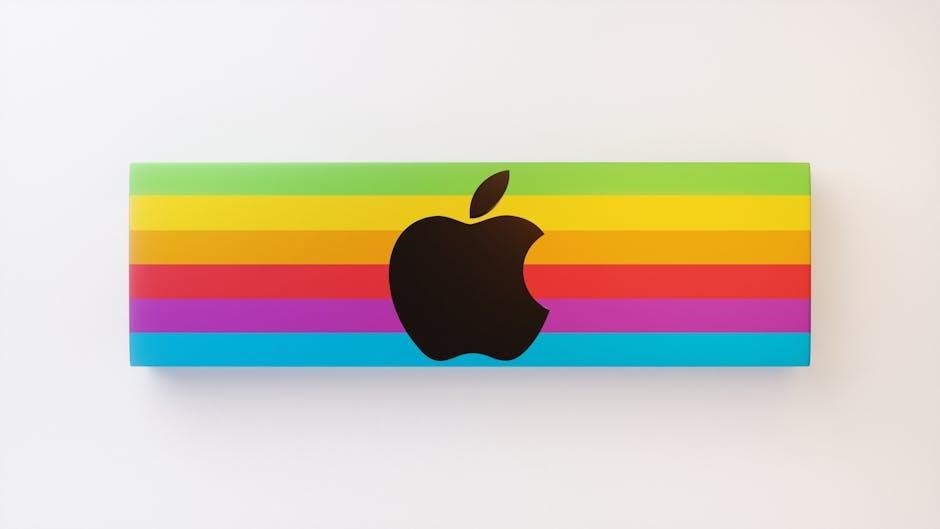Logo Modernism is a design movement emphasizing simplicity‚ clean lines‚ and functionality‚ rooted in early 20th-century modernist principles. It strips design to its essence‚ focusing on geometric shapes and minimalism.
1.1 Definition and Scope of Logo Modernism
Logo Modernism refers to a design philosophy that emphasizes minimalism‚ functionality‚ and clarity in logo creation. It draws from early 20th-century modernist principles‚ prioritizing clean lines‚ geometric shapes‚ and simplicity.
This approach rejects unnecessary embellishments‚ focusing instead on conveying meaning through form and color. The scope of Logo Modernism extends beyond aesthetics‚ influencing branding strategies and corporate identities.
Logo Modernism‚ as explored in Jens Müller and R. Roger Remington’s book‚ highlights how modernist ideas have shaped logo design historically and continue to inspire contemporary practices. It serves as a foundational framework for designers aiming to create timeless‚ impactful brands.
The movement’s emphasis on critical thinking and analysis makes it a cornerstone for both designers and enthusiasts seeking to understand the evolution of modern logo design.
1.2 Historical Context of Modernist Design

Modernist design emerged in the early 20th century‚ influenced by movements like Bauhaus‚ Constructivism‚ and De Stijl. These movements emphasized functionality‚ simplicity‚ and the elimination of ornamentation.
In logo design‚ modernist principles translated into clean lines‚ geometric shapes‚ and a focus on clarity. The movement gained momentum in the 1920s and 1930s‚ aligning with industrialization and the rise of corporate branding.
Designers like Piet Mondrian and Kazimir Malevich inspired modernist aesthetics‚ which later influenced logo trends. By the mid-20th century‚ modernist design became synonymous with professionalism and innovation‚ shaping the visual identity of corporations worldwide.
The historical context of modernist design laid the groundwork for contemporary logo design‚ emphasizing timeless appeal over fleeting trends. This foundation continues to inspire designers today.
Key Principles of Modernist Logo Design
Modernist logo design revolves around minimalism‚ clean lines‚ and geometric forms‚ emphasizing functionality and simplicity. Color theory and typography play crucial roles in creating timeless‚ impactful visual identities;
2.1 Minimalism and Simplicity in Logos
Minimalism and simplicity are cornerstones of modernist logo design‚ focusing on stripping away unnecessary elements to convey a clear‚ direct message. By eliminating clutter‚ logos achieve a timeless appeal that resonates universally. This approach ensures that the brand’s essence is communicated without distraction‚ making it easily recognizable and memorable. The use of simple forms and clean lines allows logos to maintain versatility across various mediums‚ from digital screens to print materials. Modernist designers often emphasize the power of whitespace‚ ensuring that each element is purposeful and contributes to the overall identity. This philosophy aligns with the modernist belief that form should follow function‚ creating logos that are both aesthetically pleasing and functional.
2.2 Geometric Shapes and Clean Lines
Geometric shapes and clean lines are fundamental elements in modernist logo design‚ providing structure and balance. Circles‚ squares‚ triangles‚ and other forms are often used to create visually appealing and organized compositions; These shapes‚ combined with clean lines‚ ensure clarity and legibility‚ making logos easily recognizable. The simplicity of geometric forms allows for scalability‚ ensuring the design remains effective across various sizes and mediums. Clean lines eliminate clutter‚ emphasizing precision and sophistication. This approach aligns with modernist principles of functionality and aesthetic harmony‚ creating logos that are both timeless and professional. The use of geometric shapes and clean lines also contributes to a sense of order and stability‚ reinforcing the brand’s identity.
2.3 Color Theory and Typography in Modernist Logos
Color theory and typography play pivotal roles in modernist logo design‚ enhancing visual appeal and communication. A limited palette often dominates‚ with bold‚ contrasting colors used to evoke emotions and ensure clarity. Typography is equally crucial‚ with sans-serif fonts like Helvetica and Futura favored for their simplicity and readability. These fonts align with modernist ideals of functionality and minimalism. The strategic use of whitespace further complements typography‚ preventing visual clutter and emphasizing the logo’s core message. Together‚ color and typography create a harmonious balance‚ reinforcing the brand’s identity and ensuring the logo remains timeless and professional. This approach reflects the modernist emphasis on precision and aesthetic coherence.

The Evolution of Modernist Principles in Logo Design
Modernist principles in logo design have evolved from early 20th-century influences to contemporary applications‚ blending minimalism‚ functionality‚ and aesthetic simplicity to create timeless brand identities.
3.1 Early Influences of Modernism on Branding
The early influences of modernism on branding emerged from the broader modernist movement in art‚ architecture‚ and design during the early 20th century. Characterized by simplicity‚ functionality‚ and clean lines‚ modernist principles began to shape logo design as a tool for corporate identity. This shift was influenced by movements like Bauhaus and Art Deco‚ which emphasized geometric forms and minimal ornamentation. Early modernist logos reflected a departure from ornate‚ traditional designs‚ embracing instead a more streamlined and rational aesthetic. This period laid the foundation for modern branding by establishing logos as symbols of clarity and professionalism‚ aligning with the ideals of modernist design.
3.2 Contemporary Applications of Modernist Aesthetics
Modernist aesthetics continue to influence contemporary logo design‚ blending simplicity and functionality with modern technology. Today‚ brands adopt minimalist approaches‚ utilizing geometric shapes and clean lines to create timeless‚ versatile logos. The use of bold typography and limited color palettes reflects a modernist emphasis on clarity and focus. Digital tools have enabled precise execution of these principles‚ ensuring consistency across various platforms. Contemporary designers also integrate subtle animations and responsive design‚ adapting modernist ideals to the digital age. This evolution demonstrates how modernist aesthetics remain relevant‚ offering a balance between heritage and innovation in branding‚ as highlighted in works like Jens Müller’s “Logo Modernism.”
The Role of “Logo Modernism” by Jens Müller and R. Roger Remington
Logo Modernism by Jens Müller and R. Roger Remington is a seminal work bridging historical context with contemporary design‚ serving as a vital resource for logo designers and enthusiasts.
4.1 Overview of the Book and Its Significance
Logo Modernism by Jens Müller and R. Roger Remington is a comprehensive exploration of modern logo design‚ emphasizing critical thinking and analysis. The book offers a structured approach‚ making complex design principles accessible to readers; It serves as a vital resource for both professionals and enthusiasts‚ providing insights into the evolution of modernist aesthetics in branding. By combining historical context with contemporary applications‚ the book bridges the gap between theory and practice. Its significance lies in its ability to inspire and educate‚ making it a cornerstone for understanding the principles of modernist logo design. The book’s informative content and engaging structure have made it a must-have for anyone interested in the field.
4.2 Key Concepts and Insights from the Book
Logo Modernism delves into the core principles of modernist design‚ emphasizing simplicity‚ functionality‚ and timelessness. It explores the use of geometric shapes‚ minimalism‚ and clean lines to create logos that are both visually striking and intellectually engaging. The book highlights the importance of balancing form and function‚ ensuring logos are not only aesthetically pleasing but also meaningful. It also examines the evolution of modernist principles‚ tracing their influence from early 20th-century art and design to contemporary branding. By focusing on critical thinking and analysis‚ the book provides readers with a deeper understanding of how modernist aesthetics can be applied to create impactful and enduring logos in today’s design landscape.

Case Studies of Notable Modernist Logos
Notable modernist logos‚ like Apple‚ IBM‚ and Braun‚ showcase simplicity‚ geometric shapes‚ and minimalism. These designs exemplify timeless branding‚ blending functionality with aesthetic appeal‚ inspiring global recognition.
5.1 Iconic Logos That Embody Modernist Principles
Iconic logos like Apple‚ IBM‚ and Braun exemplify modernist principles through their minimalism‚ clean lines‚ and geometric simplicity. Apple’s logo‚ with its stripped-down apple silhouette‚ embodies simplicity and universality. IBM’s logo‚ designed by Paul Rand‚ uses bold typography and grid-based alignment to convey corporate professionalism. Braun’s logo‚ crafted by Dieter Rams‚ reflects functional purity and clarity. These logos demonstrate how modernist design aligns with brand identity‚ creating timeless and globally recognizable symbols. Their reliance on simplicity and functionality underscores the enduring influence of modernist aesthetics in branding.
5.2 Analysis of Their Design and Impact
Modernist logos are celebrated for their ability to communicate complex ideas through simplicity. Their designs often rely on bold typography‚ geometric shapes‚ and a limited color palette‚ creating a sense of timelessness. These logos are not just visually striking but also deeply functional‚ as they transcend language barriers and cultural differences. The impact of modernist logos lies in their universality and adaptability‚ making them enduring symbols of corporate identity. They inspire trust and recognition‚ qualities that are invaluable in branding. By stripping away unnecessary elements‚ modernist logos achieve clarity‚ ensuring their relevance in an ever-changing marketplace. Their influence continues to shape contemporary design‚ proving the power of restraint in creativity.

The Future of Logo Modernism
Logo modernism will evolve by integrating digital innovation while maintaining minimalist principles‚ ensuring designs remain timeless and adaptable in a rapidly changing technological landscape.
6.1 Emerging Trends in Modernist Design
Emerging trends in modernist design emphasize the fusion of analog and digital techniques‚ creating dynamic yet minimalist visuals. Micro-interactions and subtle animations are being incorporated to add depth without compromising simplicity. The use of variable fonts and responsive design allows logos to adapt seamlessly across platforms‚ ensuring consistency and modernity. Additionally‚ there is a growing focus on sustainability‚ with designers opting for eco-friendly color palettes and minimalistic elements that reduce visual clutter. Accessibility is also becoming a priority‚ with inclusive design practices ensuring logos are legible and navigable for all users. These trends highlight how modernist principles continue to evolve‚ blending tradition with innovation to meet contemporary demands.
6.2 Predictions for the Evolution of Logo Design
The future of logo design is expected to blend classic modernist principles with cutting-edge technologies. Artificial intelligence and machine learning will likely play a larger role‚ enabling hyper-personalized logos that adapt in real-time to user interactions. Variable fonts and responsive design will continue to dominate‚ ensuring logos remain fluid across devices. Brands may also embrace augmented reality (AR) and virtual reality (VR) to create immersive logo experiences. Sustainability will influence design choices‚ with a focus on eco-friendly color palettes and minimalistic elements. Ultimately‚ logo design will evolve into a dynamic‚ interactive medium that maintains the timeless appeal of modernist aesthetics while embracing innovation.



0 Comments